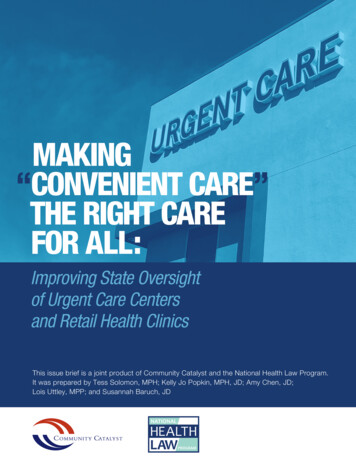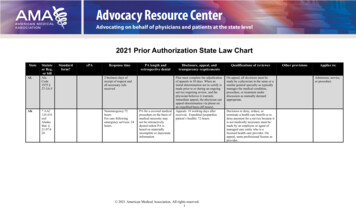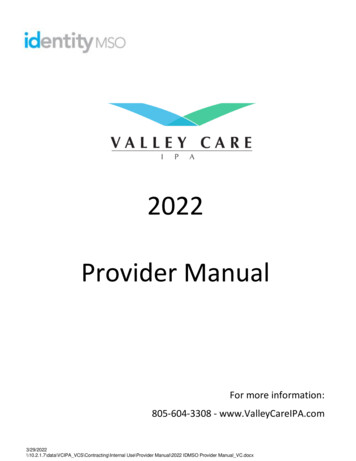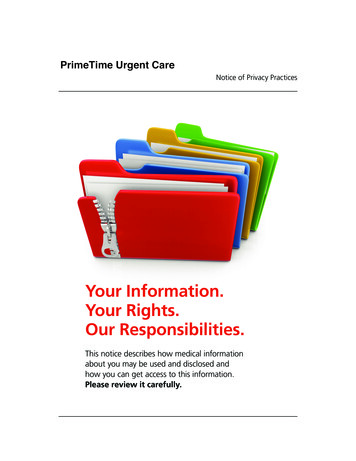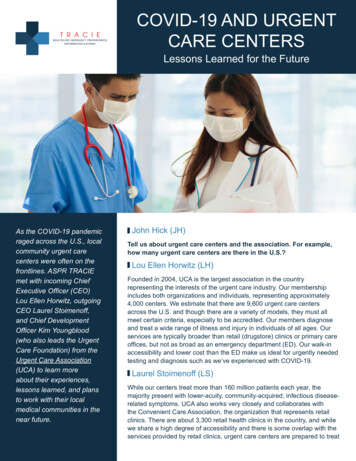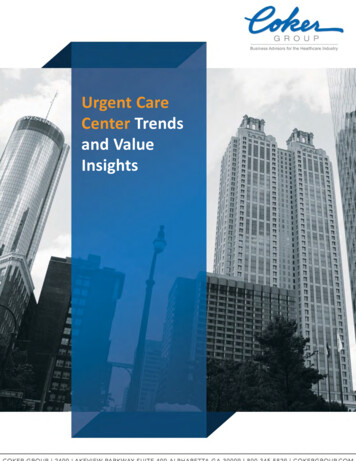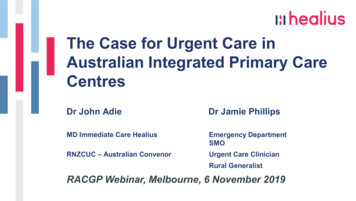
Transcription
The Case for Urgent Care inAustralian Integrated Primary CareCentresDr John AdieDr Jamie PhillipsMD Immediate Care HealiusEmergency DepartmentSMORNZCUC – Australian ConvenorUrgent Care ClinicianRural GeneralistRACGP Webinar, Melbourne, 6 November 2019
1.0 IntroductionJohn 8/Jamie ips-294a667a/
Polling Questions:Do you feel your current model of General Practice would be threatened by UrgentCare?Would you be interested in a career in Urgent Care that complimented your coreGeneral Practice?3
1.0 IntroductionNon life-threatingurgent condition
1.0 IntroductionNon life-threatingurgent conditionAlso referred to as:Health care consumer abuse (Durand et al. 2012)Inappropriate referrals (Becker et al. 2012)Inappropriate attendance (Carret et al. 2007)Low-urgency, self referred patients better managed byother services (McHale et al. 2013)
1.0 IntroductionNon life-threatingurgent conditionLife-threatening urgentcondition
2.0 Problem: Patient presenting to ED with NLTUC2.1 ED presentations are increasing by up to 7% per year in Australia andother developed countries like UK, US, Canada, NZ & Switzerland7
2.0 Problem: Patient presenting to ED with NLTUC2.1 ED presentations are increasing by up to 7% per year in Australia and otherdeveloped countries like UK, US, Canada, NZ & Switzerland2.1.1 Contributing factors:- Limited access to primary care8
2.0 Problem: Patient presenting to ED with NLTUC2.1 ED presentations are increasing by up to 7% per year in Australia and otherdeveloped countries like UK, US, Canada, NZ & Switzerland2.1.1 Contributing factors:- Limited access to primary care- EDs are societies' core safety net provider9
2.0 Problem: Patient presenting to ED with NLTUC2.1 ED presentations are increasing by up to 7% per year in Australia and otherdeveloped countries like UK, US, Canada, NZ & Switzerland2.1.1 Contributing factors:- Limited access to primary care- EDs are societies' core safety net provider- Increased presentations partly due to those that could bemanaged in primary care10
11
2.0 Problem: Patient presenting to ED with NLTUC2.2 Cost of health is increasing12
2.0 Problem: Patient presenting to ED with NLTUC2.2 Cost of health is increasing2.3 Of those considered ‘non-urgent’ 7.6% are admitted - so the decisionas to what is ‘urgent’ needs to belong to the patient (13
2.0 Problem: Patient presenting to ED with NLTUC2.2 Cost of health is increasing2.3 Of those considered ‘non-urgent’ 7.6% are admitted - so the decision as towhat is ‘urgent’ needs to belong to the patient (2.4 Increased presentations especially on the weekend contribute toOVERCROWDING - which impedes ED functioning, increases inpatient stay,patient dissatisfaction, error, delay in diagnosis and treatment, higher chance ofDNW, cost, morbidity, staff stress and mortality14
40003500Total Number of category 4 & 5 presentationsfor 2013/2014 by dayPresentations per ThursdayCaloundra EDFridayNambour EDSaturdaySunday
2.0 Problem: Patient presenting to ED with NLTUC2.2 Cost of health is increasing2.3 Of those considered ‘non-urgent’ 7.6% are admitted - so the decision as towhat is ‘urgent’ needs to belong to the patient (2.4 Increased presentations especially on the weekend contribute toovercrowding - which impedes ED functioning, increases inpatient stay, patientdissatisfaction, error, delay in diagnosis and treatment, higher chance of DNW,cost, morbidity, staff stress and mortality2.5 Slowness to embrace solutions:- expanding the ED- referring patients off-site- developing primary care based solutions16
3.0 Solutions in the Literature
Emerging Models of Community Health care- for NLTUCCategoryTelemedicine - virtual, most limited access toresourcesHouse calls – face to face interaction with limitedaccess to resourcesLocation based - face to face with access to moreresources18Description of models1.Non-clinical call handler managed2.Nurse managed3.GP managed4.New Prehospital Practitioner Community Care5.Nurse practitioner led6.GP led7.Urgent Care Community Pharmacy8.Advanced Nurse Enhancement of Primary Care9.Nurse Practitioner in nurse led clinics10. On-site employer clinic11. Urgent Care Clinic12. Freestanding Emergency Department13. Integrated Primary Care Centre
Emerging Models of Community Health care- for NLTUCCategoryTelemedicine - virtual, most limited access toresourcesHouse calls – face to face interaction with limitedaccess to resourcesLocation based - face to face with access to moreresources19Description of models1.Non-clinical call handler managed2.Nurse managed3.GP managed4.New Prehospital Practitioner Community Care5.Nurse practitioner led6.GP led7.Urgent Care Community Pharmacy8.Advanced Nurse Enhancement of Primary Care9.Nurse Practitioner in nurse led clinics10. On-site employer clinic11. Urgent Care Clinic12. Freestanding Emergency Department13. Integrated Primary Care Centre
3.0 Literature review3.1 Non-GP non-ED modelsmanaging patients with NLTUCcan be built on/expanded in theAustralian context New Prehospital PractitionerCommunity Care(Mason et al. 2007, Gray & Walker 2008, Blacker et al. 2009,Tohira et al. 2014) Urgent Care Pharmacies Advanced Nurse Enhancement ofPrimary Care Designated Urgent Care Clinics Integrated Primary Care Centres
3.0 Literature review3.1 Non-GP non-ED modelsmanaging patients with NLTUCcan be built on/expanded in theAustralian context New Prehospital Practitioners Urgent Care Pharmacies(Hayes et al. 2000, Williams et al. 2011, Gauld et at.2012, Parsons et al. 2012, Klepser et al. 2012) Advanced Nurse Enhancement ofPrimary Care Designated Urgent Care Clinics Integrated Primary Care Centres
3.0 Literature review3.1 Non-GP non-ED modelsmanaging patients with NLTUCcan be built on/expanded in theAustralian context New Prehospital Practitioner CommunityCare Urgent Care Pharmacies Advanced Nurse Enhancement ofPrimary Care(Hanson Turton et al. 2007, Bonsall & Cheater 2008,Elsom et al. 2009, Swan et al. 2015) Designated Urgent Care Clinics Integrated Primary Care Centres
3.0 Literature review3.1 Non-GP non-ED modelsmanaging patients with NLTUCcan be built on/expanded in theAustralian context New Prehospital Practitioner CommunityCare Urgent Care Pharmacies Advanced Nurse Enhancement ofPrimary Care Designated Urgent Care Clinics(Sibbald 2000, Mehotra et al. 2008, Weinick et al.2009, Zimmerman 2013, Qin et al. 2015) Integrated Primary Care Centres
3.0 Literature review3.1 Non-GP non-ED modelsmanaging patients with NLTUCcan be built on/expanded in theAustralian context New Prehospital Practitioner CommunityCareUrgent Care PharmaciesAdvanced Nurse Enhancement ofPrimary CareDesignated Urgent Care ClinicsIntegrated Primary Care Centres(Powell Davies et al. 2010, Smith and Bywood 2012,Thomas 2013, Bulletin of the WHO 2015, Barker et al. 2017)
3.0 Literature review3.2 Identifiable demographic/clinicalcharacteristics of patients presentingto ED with NLTUC(Anderson & Gaudry 1984, Dale et al., 1995, Young et al. 1996, Ward et al. 1996,Giesen et al. 2006, Carret et al. 2007, Philips et at. 2010, Fortuna et al. 2010,Begley et al. 2010, Kaskie et al. 2011, Chmiel et al. 2011, McHale et al. 2013,Shaw et al. 2013, Swaverly et al. 2015, Freed et al. 2015, Seccombe et al. 2015,Dale et al. 1995, Shipman et at. 1997, Harris & McDonald 1997, Philips at al.2010, Chmiel et al. 2011)
3.0 Literature review3.3 Reasons for patientschoosing GP or ED(Young et al. 1996, Shipman et al. 1997, Shipman & Dale 1999,Koziol-McLain et al. 2000, Ryan et al. 2005, Young et al. 2006,Masso et al. 2007, Berry 2008, Procter et al. 2009, Philips 2010,Ahmed and Fincham 2010, Begley et al. 2010, West 2011, Becker etal. 2012, Philips 2012, Durand et al. 2012, Shaw et al. 2013,Gunther et al. 2013, Palmer et al. 2014, Alyasin & Douglas 2014,Acosta & Lima 2015, Swavely et al. 2015)
3.0 Literature review3.4 Reasons GPs provide forNLTUC and work after hours/weekends/ public holidays(Cathebras et al 2004, van Uden et al. 2005, Whalley et al. 2006,Bogue et al, 2006, May et al. 2008, Shanafelt et al. 2012, Galam etal. 2013, Smits et al. 2014, Dale et al. 2015)
3.5 Summary of Literature Review- 5 non GP/non ED models including IPCC (but gap in literature)- Demographics/ presentation reasons of patients presenting to ED- Patients tell us why they go to ED with NLTUC instead of the GP- GP’s tell us what it takes for them to see NLTUC and work after hours28
3.5 Summary of Literature Review- 5 non GP/non ED models including IPCC (but gap in literature)- Demographics/ presentation reasons of patients presenting to ED- Patients tell us why they go to ED with NLTUC instead of the GP- GP’s tell us what it takes for them to see NLTUC and work after hours29
3.5 Summary of Literature Review- 5 non GP/non ED models including IPCC (but gap in literature)- Demographics/ presentation reasons of patients presenting to ED- Patients tell us why they go to ED with NLTUC instead of the GP- GP’s tell us what it takes for them to see NLTUC and work after hours30
3.5 Summary of Literature Review- 5 non GP/non ED models including IPCC (but gap in literature)- Demographics/ presentation reasons of patients presenting to ED- Patients tell us why they go to ED with NLTUC instead of the GP- GP’s tell us what it takes for them to see NLTUC and work after hours31
So what now?32
So what now?Extreme Ownership33
So what now?4.0 Research5.0 Consider providing anUrgent Care Service6.0 Public PrivatePartnershipsPiggybacking on UrgentCare34
4.0 Research4.1 Get help from a University – why not enrol?35
Case Study Methodology(Krejcie & Morgan 1970, Eisenhardt 1989, Polit & Hungler 1991, Cavana et al. 2000,Sikmund 2003, Newman 2003, Shuttleworth 2009 (3 references), Yin 2015)1)Getting started2)Case selection3)Data collection4)Data analysis5)Validity and Reliability6)Enfolding Literature7)Reaching closure Research Problem & Questions
Case Study MethodologyResearch problem:It is unclear whether UCC in IPCCs can provide an alternative with equal or betteroutcomes to ED for those with NLTUC and improve the problem of overcrowding inAustralian EDs37
Case Study MethodologyResearch questions:1. What are the characteristics and management of patients presenting without anappointment to two IPCCs as compared to an ED in a regional centre on QueenslandAustralia?2. What factors influence the decision making of patients with NLTUCs related topresentation at an ED compared to an IPCC?38
Case Study Methodology1)Getting started2)Case selection3)Data collection4)Data analysis5)Validity and Reliability6)Enfolding Literature7)Reaching closure Service delivery organisations onthe SC – x2 IPCC x1 ED Patients attending different clinics
Case Study Methodology1)Getting startedPhase 1:2)Case selection3)Data collection4)Data analysis5)Validity and ReliabilityResearch Design: Retrospective,descriptive, comparative: clinicalcharacteristics, outcomes of 2 IPCCand 1 ED6)Enfolding Literature7)Reaching closureChart Audit:Data derived from patient records
Case Study Methodology1)Getting startedPhase 2:2)Case selection3)Data collection (cont’d)4)Data analysis5)Validity and ReliabilityResearch Design: Patient survey ofthose attending an IPCC or ED withNLTUC to find out what influencestheir decision to present.6)Enfolding LiteratureSurvey development, piloting and redevelopment7)Reaching closureData derived from survey
Case Study Methodology1)Getting startedPhase 1:2)Case selection3)Data collection4)Data analysis5)Validity and ReliabilityStatistical analysis – Describe samplecharacteristics using frequency,percentage, measures of centraltendency and distribution6)Enfolding Literature7)Reaching closureBivariate comparison of outcomesand costs with a range of clinicalcharacteristics – correlation and chisquareMultivariate modelling
Case Study Methodology1)Getting started2)Case selection3)Data collection4)Data analysis (cont’d)5)Validity and Reliability6)Enfolding Literature7)Reaching closurePhase 2:Statistical analysis – Describe samplecharacteristics and survey itemresponses using frequency, percentage,measures of central tendency anddistributionExplore relationships between variables
Case Study Methodology441)Getting started2)Case selection3)Data collection4)Data analysis5)Validity and Reliability6)Enfolding Literature7)Reaching closure
Case Study Methodology451)Getting started2)Case selection3)Data collection4)Data analysis5)Validity and Reliability6)Enfolding Literature7)Reaching closure
Descriptive data of Top 30 non-booked presentations to Ochre Health Medical Centre–Sippy Downs Sundays 2015(n 2077) c.f. Beach Data (n 194100) (Unpublished and non-peer reviewed) Dr John Adie, Dr Wayne Graham & Professor Marianne Wallis 2019 – University of the Sunshine Coast46
4.0 Research4.1 Why not enrol in a University?4.2 Join a collaborativeJohn.Adie@healius.com.au47
5.0 Consider providing an Urgent Care Service48
5.1 What is Urgent Care?Urgent CareEpisodic, extended hours care in thecommunity allowing treatment of a largerange of lower acuity conditionsClinics exist in the US, Canada, UK, NZ,Australia, Hungry, Israel & Bahrain49
Urgent Care5.2 Urgent Care – USUS- Four Levels of accreditation- 1/3 – 1/5 cost of a hospital ED-50Governing bodies:- Urgent Care Association of America- American Academy of Urgent Care MedicineEpisodic, extended hours care in thecommunity allowing treatment of a largerange of lower acuity conditionsClinics exist in the US, Canada, UK, NZ,Australia, Hungry, Israel & Bahrain
51
Urgent Care:5.3 Urgent Care – NZ & AustraliaNZ- Open 0800 – 2000, 7/7/365, XR, MD,RNZCUC Standard52-Models-Alternative Sources of Funding:- ACC- Hospital- POAC for IV antibiotics, IVfluids, short stay for COPD/asthma-Governing body: RNZCUC-Lowest rate of ED admissions in theWestern World (Table 1)Episodic, extended hours care in thecommunity allowing treatment of a largerange of lower acuity conditionsClinics exist in the US, Canada, UK, NZ,Australia, Hungry, Israel & Bahrain
IPCC Models:53
Elizabeth Medical & Dental54
Urgent Care:5.3 Urgent Care – NZ & AustraliaNZ- Open 0800 – 2000, 7/7/365, XR, MD,RNZCUC Standard55-Models-Alternative Sources of Funding:- ACC- Hospital- POAC for IV antibiotics, IVfluids, short stay for COPD/asthma-Governing body: RNZCUC-Lowest rate of ED admissions in theWestern World (Table 1)Episodic, extended hours care in thecommunity allowing treatment of a largerange of lower acuity conditionsClinics exist in the US, Canada, UK, NZ,Australia, Hungry, Israel & Bahrain
56
Urgent Care:5.3 Urgent Care – NZ & AustraliaNZ- Open 0800 – 2000, 7/7/365, XR, MD,RNZCUC Standard57-Models-Alternative Sources of Funding:- ACC- Hospital- POAC for IV antibiotics, IVfluids, short stay for COPD/asthma-Governing body: RNZCUC-Lowest rate of ED admissions inthe Western World (Table 1)Episodic, extended hours care in thecommunity allowing treatment of a largerange of lower acuity conditionsClinics exist in the US, Canada, UK, NZ,Australia, Hungry, Israel & Bahrain
Innovations in UrbanPrimary Care:Urgent CareEpisodic, extended hours care in thecommunity allowing treatment of a largerange of lower acuity conditions1) Urgent Care in Integrated PrimaryCare CentresAvAucklandNZAus UKUSCan184311408476345Table 1: ED admission rate/ 1,000 (Clearwater, 2014)58Clinics exist in the US, Canada, UK, NZ,Australia, Hungry, Israel & Bahrain
Australian Urgent Care Clinics:59
Australian Urgent Care Clinics:60
Australian Urgent Care Clinics:61
Table 4: Costing of 5 lower acuity presentations inAustralian and NZ UCC & GPPresentationsNZ UCCNZ GPAustralianGP AU36.30Normal hours consult up to 70.5320 minutes.(accidents) a NZ35.48(accidents) aSingle site burn 4 cm 2IV rehydration ofgastroenteritis (over 1hour)Intravenous cephazolin(non-septic cellulitis) NZ 142.00 NZ 170 NZ 107.38 NZ 170 AU39.55 AU70.30 NZ 125.5 NZ 125.5 AU36.60 NZ 164.47 b AU36.60 bNon-displaced distal radiusfracture (initial consult). NZ 172.03 bSource: (Accident Compensation Corporation New Zealand, 2016; Australian Government Department of Health, 2016)a Complicated funding arrangements depending on capitation rules for medical conditions.b If whole fracture episode not managed.62Select 'Insert Header & Footer' to add footer
Urgent Care5.2 Urgent Care – UK, Europe, IsraelEpisodic, extended hours care in thecommunity allowing treatment of a largerange of lower acuity conditionsClinics exist in the US, Canada, UK, NZ,Australia, Hungry, Israel & Bahrain63
Evidence of Primary Care Initiatives:Continuity of care- 9% fewer lower acuity admissions (Barker, Steventon, & Deeny, 2017)Prime Minister’s Challenge Fund England: First wave, weekend appointments (Cecil et al., 2016; Dolton & Pathania, 2016; FowlerDavis, Piercy, Pearson, Thomas, & Kelly, 2018; Whittaker et al., 2016)9% reduction in paediatric admissions through ED10% reduction in A&E attendances overall18 % decrease in weekend A&E attendances overall in patients registered at the pilot practices in London26% relative reduction in Manchester for minor problemsUrgent Care in Chile (Pacheco, Cuadrado, & Martínez-Gutiérrez, 2019)- 3% reduction in ED visits (more with adult & elderly)- 6% decrease in same day visits to GP (more in children & adolescents)AH General Practice (Buckley, Curtis, & McGirr, 2010; Crawford, Cooper, Cant, & DeSouza, 2017; C. J. T. van Uden & Crebolder, 2004)8 % reduction in category 4 & 5 presentations to a Base Hospital ED in NSW9% total reduction in the Netherlands64Reduce a proportion of ED presentations in less urgent patient categories with nurse-led triage of medical emergency care
6.0 Public/ PrivatePartnerships piggybackingUrgent Care65
PPPs piggybacking UC:6.1 Primary Care Fracture Clinic6640% 16 y.o. referred to Hospital FractureClinic assessed as suitable for PCFC atLogan & Redlands Hospitals
PPPs piggybacking UC:6.1 Primary Care Fracture Clinic40% 16 y.o. referred to Hospital FractureClinic assessed as suitable for PCFC atLogan & Redlands HospitalsQld Health Collaboration b/w HIU, CED,SCHHS & OHMC-SC - 201467
PPPs piggybacking UC:6.1 Primary Care Fracture Clinic40% 16 y.o. referred to Hospital FractureClinic assessed as suitable for PCFC atLogan & Redlands HospitalsQld Health Collaboration b/w HIU, CED,SCHHS & OHMC-SC - 2014Top six fractures: making 80% of referrals68
PPPs piggybacking UC:6.1 Primary Care Fracture Clinic40% 16 y.o. referred to Hospital FractureClinic assessed as suitable for PCFC atLogan & Redlands HospitalsQld Health Collaboration b/w HIU, CED,SCHHS & OHMC-SC - 2014Top six fractures: making 80% of referralsTop six treatments: above & below elbowcast, below knee cast, shoulderimmobiliser, cobra cast and Moon boot69
PPPs piggybacking UC:6.1 Primary Care Fracture Clinic40% 16 y.o. referred to Hospital FractureClinic assessed as suitable for PCFC atLogan & Redlands HospitalsQld Health Collaboration b/w HIU, CED,SCHHS & OHMC-SC - 2014Top six fractures: making 80% of referralsTop six treatments: below elbow cast,shoulder immobiliser, above and belowelbow case, cobra cast and Moon bootCED Evaluation70
PPPs piggybacking UC:6.1 Primary Care Fracture ClinicRESULTS:-Cost 18K c.f. %116 – 145K if model not operating-Patients wait clinically recommended reduced by 26%-40% increase in conversion rate to surgery-Patients & clinicians satisfied - primary care location reducedgeneral inconvenience, travel time, reduced waiting time &cost40% 16 y.o. referred to Hospital FractureClinic assessed as suitable for PCFC atLogan & Redlands HospitalsQld Health Collaboration b/w HIU, CED,SCHHS & OHMC-SC - 2014Top six fractures: making 80% of referralsTop six treatments: below elbow cast,shoulder immobiliser, above and belowelbow case, cobra cast and Moon bootCED Evaluation – see over71
PPPs piggybacking UC:6.1 Primary Care Fracture ClinicTWO MAIN WEBSITES:40% 16 y.o. referred to Hospital FractureClinic assessed as suitable for PCFC atLogan & Redlands Hospitals1) Ortho-bulletsQld Health Collaboration b/w HIU, CED,SCHHS & OHMC-SC - 20142) Royal Children’s Hospital MelbourneFracture Clinic GuidelinesTop six fractures: making 80% of referralsTop six treatments: below elbow cast,shoulder immobiliser, above and belowelbow case, cobra cast and Moon bootCED EvaluationWebsites:72
PPPs piggybacking UC:6.2 GP Lead – Hospital in the Home73
PPPs piggybacking UC:Two HITH Models6.2 GP Lead – Hospital in the Home74-Admission Avoidance-Early Discharge
PPPs piggybacking UC:Two HITH Models6.2 GP Lead – Hospital in the Home-Admission Avoidance-Early DischargeThree Cochrane Reviews & One MetaAnalysis75-Patient & carer satisfaction-Carer burden-Mortality & readmission-Hospital stay-Cost
PPPs piggybacking UC:Two HITH Models6.2 GP Lead – Hospital in the Home- Five DRGs grew-Admission Avoidance-Early Discharge- Findings & Key LearningsThree Cochrane Reviews & One MetaAnalysis76-Patient & carer satisfaction-Carer burden-Mortality & readmission-Hospital stay-Cost
PPPs piggybacking UC:St John Ambulance 20166.3 Ambulance Diversion77
PPPs piggybacking UC:St John Ambulance 20166.3 Ambulance DiversionSpot-On Hospital Avoidance Qld 201678
PPPs piggybacking UC:St John Ambulance 20166.3 Ambulance DiversionSpot-On Hospital Avoidance Qld 2016West Midlands of England 201779
PPPs piggybacking UC:St John Ambulance 20166.3 Ambulance DiversionSpot-On Hospital Avoidance Qld 2016West Midlands of England 2017Health Hub Doctors Morayfield 201780
PPPs piggybacking UC:St John Ambulance 20166.3 Ambulance DiversionSpot-On Hospital Avoidance Qld 2016West Midlands of England 2017Health Hub Doctors Morayfield 2017Priority Care Centres South Australia 201981
PPPs piggybacking UC:6.4 Homeless Medicine82-‘People living on the streets or other places not intendedfor human habitation, living in shelters, lacking a fixedregular residence, temporarily staying with friends &families’-Demographic- Male- 25 – 44- 50-Morbidity & Mortality- Chronic illness- Substance Abuse- Mental Illness- Mortality increased 3 – 6 times-Current Homeless ED/ Inpatient Healthcare Pathway- 72 – 77%- 50%- 33%
PPPs piggybacking UC:6.4 Homeless Medicine – Primary Care SolutionWHO Primary Care Definition:‘the first level of contact of individuals, the family &community with the national health system bringinghealth care as close as possible to where peoplelive & work, & constitutes the first element of acontinuing health care process’-Enrolment - Less likely reducing with time on the street-Successful Models:1) Tailored & orientated to homeless2) Multi-disciplinary Team – GPs & RNs3) Integration: social support & community healthengagement4) Co-location – GP, mental health, social support services83
PPPs piggybacking UC:6.4 Homeless Medicine – Primary Care Solution-Benefits – lack of high quality studies but:Social & housing statusAccess/ use of health care servicesDiagnosis/ Management of chronic diseaseCare ExperienceReduced ED visits & Inpatient Stays84
PPPs piggybacking UC:6.5 New Technologies1) Point of Care Testing- POCUS- Laboratory Testing2) Hybrid Decision Making ToolsABBC85
7.0 Resources7.1 Internal86Select 'Insert Header & Footer' to add footer
SWIFTQ Immediate Care Patient Profile87
88
89
90
91
92
93
7.0 Resources7.1 Internal7.2 RNZCUC7.2.1 Standard94
95
Webpage for Registering Interest for the RNZCUCin ocational-registration-in-australia/96
7.0 Resources7.1 Internal7.2 RNZCUC7.2.1 Standard7.2.2 CME97
7.0 Resources7.1 Internal7.2 RNZCUC7.2.1 Standard7.2.2 CME7.2.3 Accelerated Fellowship Pathway – ACEM, ACRRM - ED98
7.0 Resources7.1 Internal7.2 RNZCUC7.3 Australia, UK, rest of the World7.3.1 Specialist Colleges – ACEM, ACCRM & RACGP7.3.2 Rural Generalist Pathway7.3.3 Appraisal & Revalidation99
7.0 Resources7.1 Internal7.2 RNZCUC7.3 Australia, UK, rest of the World7.3.1 Specialist Colleges – ACEM, ACCRM & RACGP7.3.2 Rural Generalist Pathway7.4 Websites100
7.0 Resources7.1 Internal7.2 RNZCUC7.3 Australia, UK, rest of the World7.3.1 Specialist Colleges – ACEM, ACCRM & RACGP7.3.2 Rural Generalist Pathway7.4 Websites7.5 Phone Apps101
8.0 Lobbying State & Federal Government so far:8.1 Other funding models102
8.0 Lobbying State & Federal Government asUrgent Care is not 9 - 58.1 Other funding models8.2 Requests for clinics open 7 days per week, 12 hours per day, 365 days per year with at least 8 FTE doctors (if met accreditationstandard):103
8.0 Lobbying State & Federal Government asUrgent Care is not 9 - 58.1 Other funding models8.2 Requests for clinics open 7 days per week, 12 hours per day, 365 days per year with at least 8 FTE doctors (if met accreditationstandard):i) Extra item numbers be introduced to the Medicare Benefits Scheme for:104-Rehydration-Cellulitis-COPD/ asthma-Short stay observation-Diversion from – ED, Ambulance or referral from other GPs
8.0 Lobbying State & Federal Government asUrgent Care is not 9 - 58.1 Other funding models8.2 Requests for clinics open 7 days per week, 12 hours per day, 365 days per year with at least 8 FTE doctors (if met accreditationstandard):i) Extra item numbers be introduced to the Medicare Benefits Scheme for:-Rehydration-Cellulitis-COPD/ asthma-Short stay observation-Diversion from – ED, Ambulance or referral from other GPsii) FACEM specialists to be able to claim Vocationally Registered Rates for:Patients presenting to clinics with Urgent Care Services rather than having to be referred patients by GP’s or Nurse Practitioners.Doctors or NPs consulting for advise by telehealth. At present, they can only get telehealth rates if consulting to GPs in Rural Areas.105
8.0 Lobbying State & Federal Government asUrgent Care is not 9 - 58.1 Other funding models8.2 Requests for clinics open 7 days per week, 12 hours per day, 365 days per year with at least 8 FTE doctors (if met accreditationstandard):i) Extra item numbers be introduced to the Medicare Benefits Scheme for:-Rehydration-Cellulitis-COPD/ asthma-Short stay observation-Diversion from – ED, Ambulance or referral from other GPsii) FACEM specialists to be able to claim Vocationally Registered Rates for:Patients presenting to clinics with Urgent Care Services rather than having to be referred patients by GP’s or Nurse Practitioners.Doctors or NPs consulting for advise by telehealth. At present, they can only get telehealth rates if consulting to GPs in Rural Areas.iii) RNZCUC Fellows to be able to claim non-CDM (Chronic Disease Management) Medicare item numbers106
8.0 Lobbying State & Federal Government asUrgent Care is not 9 - 58.1 Other funding models8.2 Requests for clinics open 7 days per week, 12 hours per day, 365 days per year with at least 8 FTE doctors (if met accreditationstandard):i) Extra item numbers be introduced to the Medicare Benefits Scheme for:-Rehydration-Cellulitis-COPD/ asthma-Short stay observation-Diversion from – ED, Ambulance or referral from other GPsii) FACEM specialists to be able to claim Vocationally Registered Rates for:Patients presenting to clinics with Urgent Care Services rather than having to be referred patients by GP’s or Nurse Practitioners.Doctors or NPs consulting for advise by telehealth. At present, they can only get telehealth rates if consulting to GPs in Rural Areas.iii) RNZCUC Fellows to be able to claim non-CDM (Chronic Disease Management) Medicare item numbersiv) RNZCUC Standard be made & accepted an Australasian Standard by which to Accredit Urgent Care Clinics(Cost estimates to make this JAS-ANZ Registered Standard an Australasian one are approximately 30 K)107
Polling Questions:Do you feel your current model of General Practice would be threatened by UC?Would you be interested in a career in UC that complimented your core GP?Are you willing to help us to help access for patients to UC in ocational-registration-in-australia/108 Select 'Insert Header & Footer' to add footer
Next Immediate Care Centres in Gold Coast,Adelaide, West Sydney & Pt ldEppingMt DruittMarionPt Macquarrie
A marketleading networkAustralia-widecoverage2,541 Total sites2,2992,191 ACCCsPathology 108 Laboratories680 Total Sites19 Total Sites212 Total Sites197 114625 21 3419v851 Total Sites61 Total Sites750 36 65497532 Total Sites96Centres75 Healius Medical Centres13 Health & Co238 Montserrat Day Hospitals28 Hospitals146Diagnostic 63 Community CentresImaging55 Medical Centres1112726 Total Sites*as at January 201926660 Total Sites606 19 35
4. New Prehospital Practitioner Community Care: 5. Nurse practitioner led. 6. GP led: Location based - face to face with access to more resources. 7. Urgent Care Community Pharmacy: 8. Advanced Nurse Enhancement of Primary Care. 9. Nurse Practitioner in nurse led clinics: 10. On-site employer clinic . 11. Urgent Care Clinic: 12. Freestanding .



